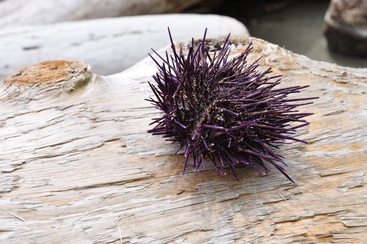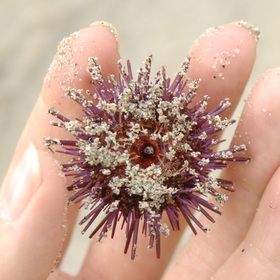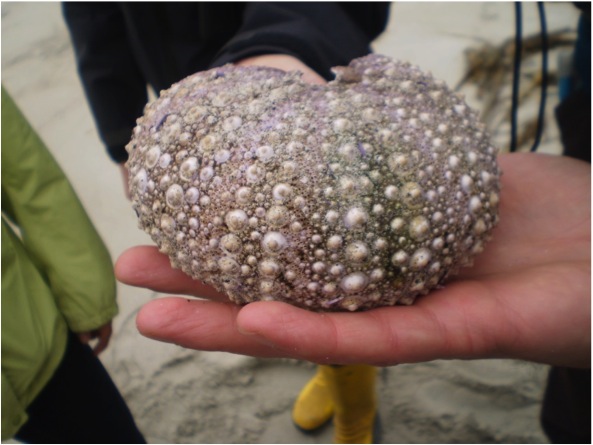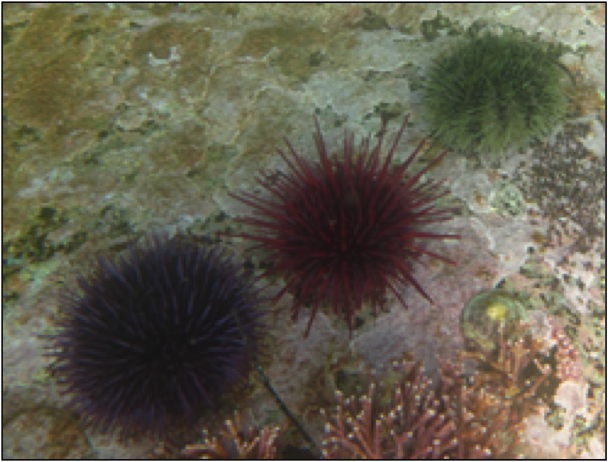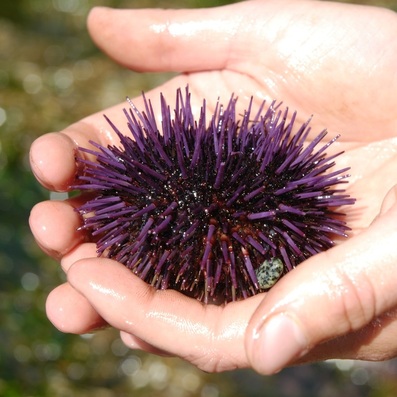Purple sea urchin, purple urchin • Strongylocentrotus purpuratus
{Strongylocentrotus = ball of spines}
|
Clockwise from bottom left: a comparison of adult purple, red, and green urchins (photo by Rosie Child); purple urchin test (photo by Alanah Nasadyk); purple urchin found on a Calvert Island beach (photo by Brian Starzomski); underside of a purple urchin; and a live purple urchin (photos by Kelly Fretwell).
|
Identification
Adult purple sea urchins are an obvious purple colour, but juveniles can have light green spines, or spines in transition from green to purple. Adult purple urchin spines are usually no longer than 2.5 cm long, although urchins living in subtidal areas may have spines up to 6 cm long. The diameter of the test (shell minus the spines) is generally under 10 cm, and the height is about half the diameter.
Habitat & Range
Purple sea urchins are found in both intertidal and subtidal zones. They are commonly found in exposed rocky areas, where they tend to erode little burrows into the rock. In intertidal areas they (and their rock depressions) can be found along shallow rocky ledges and in tidepools. This species is found along the west coast of North America from Cook Inlet in Alaska to Mexico; it is less common in the northern end of its range than the southern.
Similar Species
The green spines of purple sea urchin juveniles can potentially cause confusion with the green sea urchin (Strongylocentrotus droebachiensis). Conversely, green sea urchins (of all ages) can sometimes be a purplish colour. When these two species don't stay true to their names, their spines must be examined for proper identification. Green urchin spines are generally thinner, shorter, and quite crowded on the urchin's test.
Small red sea urchins can be reddy-purple in colour, but grow larger and have much longer spines.
Human Uses
This species is commercially harvested, mostly in California, and exported to Japan where the species is considered a delicacy.
Intriguing Info
Purple urchins are very well studied due to their important ecological role. They graze voraciously on algae, particularly kelp beds, and as a result can greatly impact habitat structure. They are part of a delicate balance: if they get out of hand they can turn a diverse kelp forest into a barren underwater landscape (termed sea urchin barrens), but meanwhile they are an important prey item for many species. These include sunflower stars, ochre stars, leather stars, some crabs, giant green anemones, and the endangered sea otter. They also compete with other grazing species like abalone. As a result a solid purple urchin presence is ecologically important, but an over-abundance can have negative consequences throughout the food web. This delicate balance is determined by many biotic and abiotic factors. Read more about the complexities of this balance here and here.
Watch a Planet Earth timelapse video showing the creation of sea urchin barrens here, and find out more about urchin barrens in BC in this blog entry from the Bamfield Marine Sciences Centre, found on Vancouver Island, BC.
Adult purple sea urchins are an obvious purple colour, but juveniles can have light green spines, or spines in transition from green to purple. Adult purple urchin spines are usually no longer than 2.5 cm long, although urchins living in subtidal areas may have spines up to 6 cm long. The diameter of the test (shell minus the spines) is generally under 10 cm, and the height is about half the diameter.
Habitat & Range
Purple sea urchins are found in both intertidal and subtidal zones. They are commonly found in exposed rocky areas, where they tend to erode little burrows into the rock. In intertidal areas they (and their rock depressions) can be found along shallow rocky ledges and in tidepools. This species is found along the west coast of North America from Cook Inlet in Alaska to Mexico; it is less common in the northern end of its range than the southern.
Similar Species
The green spines of purple sea urchin juveniles can potentially cause confusion with the green sea urchin (Strongylocentrotus droebachiensis). Conversely, green sea urchins (of all ages) can sometimes be a purplish colour. When these two species don't stay true to their names, their spines must be examined for proper identification. Green urchin spines are generally thinner, shorter, and quite crowded on the urchin's test.
Small red sea urchins can be reddy-purple in colour, but grow larger and have much longer spines.
Human Uses
This species is commercially harvested, mostly in California, and exported to Japan where the species is considered a delicacy.
Intriguing Info
Purple urchins are very well studied due to their important ecological role. They graze voraciously on algae, particularly kelp beds, and as a result can greatly impact habitat structure. They are part of a delicate balance: if they get out of hand they can turn a diverse kelp forest into a barren underwater landscape (termed sea urchin barrens), but meanwhile they are an important prey item for many species. These include sunflower stars, ochre stars, leather stars, some crabs, giant green anemones, and the endangered sea otter. They also compete with other grazing species like abalone. As a result a solid purple urchin presence is ecologically important, but an over-abundance can have negative consequences throughout the food web. This delicate balance is determined by many biotic and abiotic factors. Read more about the complexities of this balance here and here.
Watch a Planet Earth timelapse video showing the creation of sea urchin barrens here, and find out more about urchin barrens in BC in this blog entry from the Bamfield Marine Sciences Centre, found on Vancouver Island, BC.
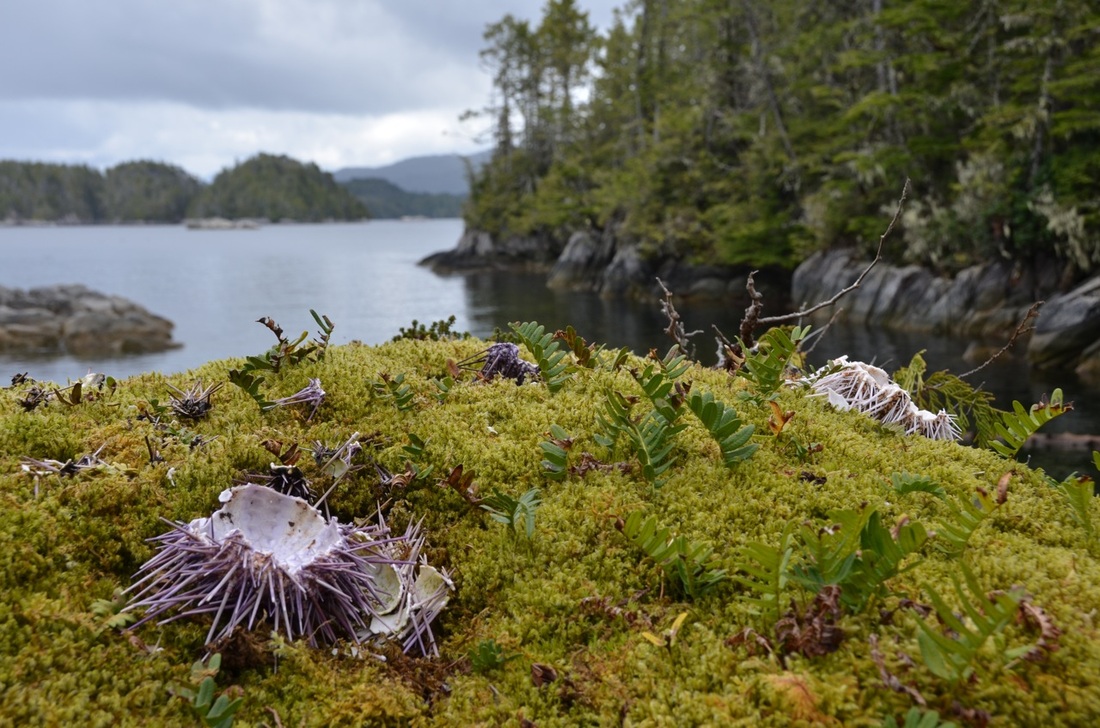
The remains of a purple urchin found scattered above the tideline by a predator. Photo by Kira Hoffman.
References
Cowles, D. (2005). Strongylocentrotus droebachiensis (O.F. Muller, 1776). Invertebrates of the Salish Sea. Rosario Beach Marine Laboratory. Accessed 12/06/2013
Cowles, D. (2005). Strongylocentrotus purpuratus (Stimpson, 1857). Invertebrates of the Salish Sea. Rosario Beach Marine Laboratory. Accessed 12/06/2013
Harbo, R. M. (1999). Whelks to whales: Coastal marine life of the Pacific Northwest. Madeira Park, BC: Harbour Publishing. P. 145
Purple sea urchin (Strongylocentrotus purpuratus). ARKive.org. Accessed 12/06/2013.
Pearse, J. S. (2006). Ecological role of Purple Sea Urchins. Science.
Authors and editors of page
Kelly Fretwell and Brian Starzomski (2013).
Cowles, D. (2005). Strongylocentrotus droebachiensis (O.F. Muller, 1776). Invertebrates of the Salish Sea. Rosario Beach Marine Laboratory. Accessed 12/06/2013
Cowles, D. (2005). Strongylocentrotus purpuratus (Stimpson, 1857). Invertebrates of the Salish Sea. Rosario Beach Marine Laboratory. Accessed 12/06/2013
Harbo, R. M. (1999). Whelks to whales: Coastal marine life of the Pacific Northwest. Madeira Park, BC: Harbour Publishing. P. 145
Purple sea urchin (Strongylocentrotus purpuratus). ARKive.org. Accessed 12/06/2013.
Pearse, J. S. (2006). Ecological role of Purple Sea Urchins. Science.
Authors and editors of page
Kelly Fretwell and Brian Starzomski (2013).
